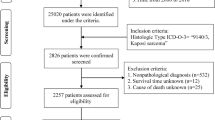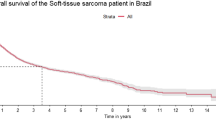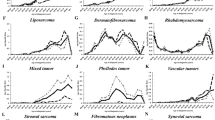Abstract
The first examination of classical Kaposi's sarcoma incidence in southern Sardinia (Italy) in 1998–2002 found the highest rate recorded in the island of 2.49 per 100 000 per year (standardised).
Similar content being viewed by others
Main
Kaposi's sarcoma (KS) is a multifocal vascular neoplasm (Ziegler et al, 1988), but the nature of the proliferating cells, and whether the lesions represent an exuberant hyperplasia or a true malignancy are still disputed (Buonaguro et al, 1995). The association with HHV8 infection in all forms of the disease (Babal and Pect, 2003) is consistent with a common pathologic process, but certain clinical-epidemiological aspects differentiate the course, the prognosis, and treatment of each form. Classical KS corresponds to the original description (Kaposi, 1872), and predominantly affects elderly males, with a higher incidence in southern and eastern European countries, with a predominance among Jews and people of Mediterranean descent (Ziegler et al, 1988, Mackie, 1992; Franceschi and Geddes, 1995). Prior to the AIDS epidemic, KS incidence rates were two- to three-fold higher in Italy than in the USA and Sweden, and as much as tenfold higher than in England and Australia (Geddes et al, 1994). In north-eastern Sardinia (Italy), classic KS incidence rate is among the highest in the world at 1.59 per 100 000 (Cottoni et al, 1996). Sardinia has a Mediterranean homogeneous island population of ancient origin; genetic studies have already demonstrated a positive association of KS with the HLA-DR5 haplotype (Contu et al, 1984).
We have investigated whether KS incidence rate is elevated also in the southern part of Sardinia, which includes the capital city Cagliari. We also compared incidence rates in urban and rural areas, as a surrogate for environmental factors in KS aetiology.
Materials and methods
Incidence of classical Kaposi's sarcoma among the resident population of the Cagliari province, aged ⩾40 years, in 1998–2002 was determined from the registries of all pathology and dermatology departments in southern Sardinia. Only clinically and histologically documented cases of classical KS were considered. Particular care was then taken to avoid including duplicated cases.
Statistical methods
Standardised incidence of classical KS in 1998–2002 was calculated, together with relevant standard errors both at the province and health district (Local Health Unit) level, using the 2001 Italian census population as the standard. Three local Health Units comprise the subunits of the Cagliari province of which one, comprising Cagliari and its metropolitan area, is mainly urban, the other two being mainly rural. Rates were truncated below the age of 40 years. Person-years for the total province, and for the urban and rural districts, were calculated by 5-year age-groups for the total resident population and by gender. The resident population outside census year (2001) was taken as being the same as in the 2001 census. We calculated the 95% confidence interval of the standardized rates as follows.

where sr and \(\overline{sr}\) are respectively the lower and upper bound of the 95% confidence interval of the standardised rate (sr), and se is its standard error, as derived from the binomial distribution (se=√pq/n, where p=rate; q=1−p; n=rate denominator). The analysis was conducted using the SPSS® software.
Results
Overall, 37 cases of classical KS (22 men and 15 women) were identified in the Cagliari province over the period 1998–2002 (Table 1), a standardised incidence rate of 2. 49 × 10−5/year (95% C.I. 1.75, 3.22). Among men, the rate was about 1.5-fold of that among women (men: 3.07 per 10−5, 95% CI 1.91, 4.23; women: 1.96, 95% CI 1.07, 2.85), and was highest among men aged 75 years or older and among women, in the 70–74-year age group. Average age at diagnosis was 74.6 years (s.d. 10.3), and it was significantly lower among men (men: 72.5 years, s.d. 10.7; women: 77.7 years, s.d. 9.1; t=2.97; P<0.01). Rates were significantly greater in the urban health district (sr=3.46, 95% CI 2.53–4.57) compared to the rural health districts (sr=1.14, 95% CI 0.34–1.94), and this was so in both genders.
Discussion
This is the first study of classic KS incidence in southern Sardinia. The high incidence rates reported in the northern areas (1.59 per 100 000 inhabitants; 2.43 for men; 0.77 for women) (Cottoni et al, 1996) are even higher in our study (2.43 per 100 000 inhabitants (2.92 for men; 1.96 for women). We also noted incidence was higher in urban than in rural districts, which is in contrast with previous reports. In the northern area of Sardinia, most cases have been observed in countryside areas, suggesting a role of contact with animals and farming cereals (Cottoni et al, 1997). Environmental factors, such as volcanic soil exposure (Montella et al, 1997), bloodsucking insects (Ascoli et al, 2003), and past history of malaria (Cottoni et al, 1997) have been investigated, but with inconsistent findings. Our results, on the other hand, suggest a parallelism with epidemic African and AIDS-related cases (Ziegler et al, 1997), in which a higher socioeconomic status has been considered as a marker for either enhanced exposure to sexually transmitted agents, including HHV8, or delayed expression of a childhood infection.
As with other oncogenic viruses, HHV8 infection alone is not sufficient for KS development (Iscovich et al, 2000) and further analytical studies are warranted to investigate the role of additional contributory factors.
References
Ascoli V, Zambon P, Manno D, Guzzinati S, Zorzi M, Area B, Costantini C, Coluzzi M (2003) Variability in the incidence of classic Kaposi's sarcoma in the Veneto region, Northern Italy. Tumori 89: 122–124
Babal P, Pect J (2003) Kaposi's sarcoma – still an enigma. J Eur Acad Dermatol 17: 377–380
Buonaguro FM, Tornesello ML, Beth-Giraldo E, Hatzakis A, Mueller N, Downing R, Biryamwaho B, Sempala SD, Giraldo G (1995) Herpesvirus-like DNA sequences detected in endemic, classic, iatrogenic and epidemic Kaposi's sarcoma (KS) sarcoma. Lancet 354: 759–761
Contu L, Cerimele D, Pintus A, Cottoni F, La Nasa G (1984) HLA and Kaposi's sarcoma in Sardinia. Tissue Antigens 23: 240–245
Cottoni F, De Marco R, Montesu MA (1996) Classical Kaposi's sarcoma in north-east Sardinia: an overview from 1977 to 1991. Br J Cancer 72: 1132–1133
Cottoni F, Masala MV, Budroni M, Rosella M, Satta R, Locatelli F, Montesu MA, De Marco R (1997) The role of occupation and a past history of malaria in the etiology of classic Kaposi's sarcoma: a case–control study in north-east Sardinia. Br J Cancer 76: 1518–1520
Franceschi S, Geddes M (1995) Epidemiology of classic Kaposi's sarcoma, with special reference to Mediterranean population. Tumori 81: 308–314
Geddes M, Franceschi S, Barchielli A (1994) Kaposi's sarcoma in Italy before and after AIDS epidemic. Br J Cancer 69: 333–336
Iscovich J, Boffetta P, Franceschi S, Azizi E, Sarid R (2000) Classic Kaposi sarcoma: epidemiology and risk factors. Cancer 88: 500–517
Kaposi M (1872) Idiopathisches multiples Pigmentsarkom der Haut. Arch Dermatol Syphil (Prague) 3: 265–273
Mackie RM (1992) Soft tissue tumours. In: Textbook of Dermatology Rook E, Wilkinson DS, Ebling FJG (eds) 5th edn, Chapter 51, pp 2088–2090, Oxford: Blackwell Scientific Publications
Montella M, Franceschi S, Geddes M, Arniani S, Cocchiarella G (1997) Classical Kaposi sarcoma and volcanic soil in southern Italy: a case-control study. Epidemiol Prev 21: 114–117
Ziegler JL, Lutzner MA, Conant MA (1988) Kaposi's sarcoma (multiple idiopathic hemorrhagic sarcoma). In: Dermatology in General Medicine Fitzpatrick TB, Eisen AZ, Wolff K, Freedberg IM, Austen KF (eds) pp 1078–1085, New York: Mc Graw-Hill
Ziegler JL, Newton R, Katongole-Mbidde E, Mbulataiye S, De Cock K, Wabinga H, Mugerwa J, Katabira E, Jaffe H, Parkin DM, Reeves G, Weiss R, Beral V (1997) Risk factors for Kaposi's sarcoma in HIV-positive subjects in Uganda. AIDS 11: 1619–1626
Author information
Authors and Affiliations
Corresponding author
Rights and permissions
From twelve months after its original publication, this work is licensed under the Creative Commons Attribution-NonCommercial-Share Alike 3.0 Unported License. To view a copy of this license, visit http://creativecommons.org/licenses/by-nc-sa/3.0/
About this article
Cite this article
Atzori, L., Fadda, D., Ferreli, C. et al. Classic Kaposi's sarcoma in southern Sardinia, Italy. Br J Cancer 91, 1261–1262 (2004). https://doi.org/10.1038/sj.bjc.6602159
Received:
Revised:
Accepted:
Published:
Issue Date:
DOI: https://doi.org/10.1038/sj.bjc.6602159
Keywords
This article is cited by
-
Classic Kaposi's sarcoma in Italy, 1985–1998
British Journal of Cancer (2005)



